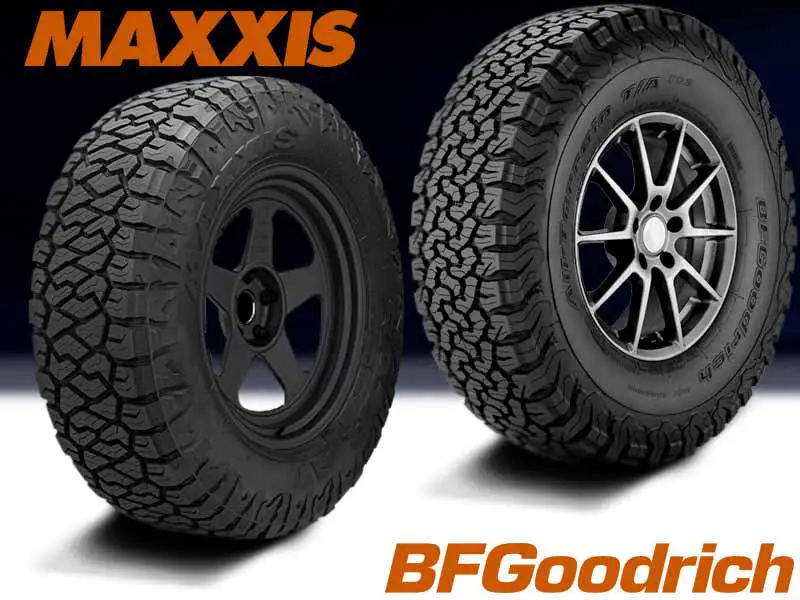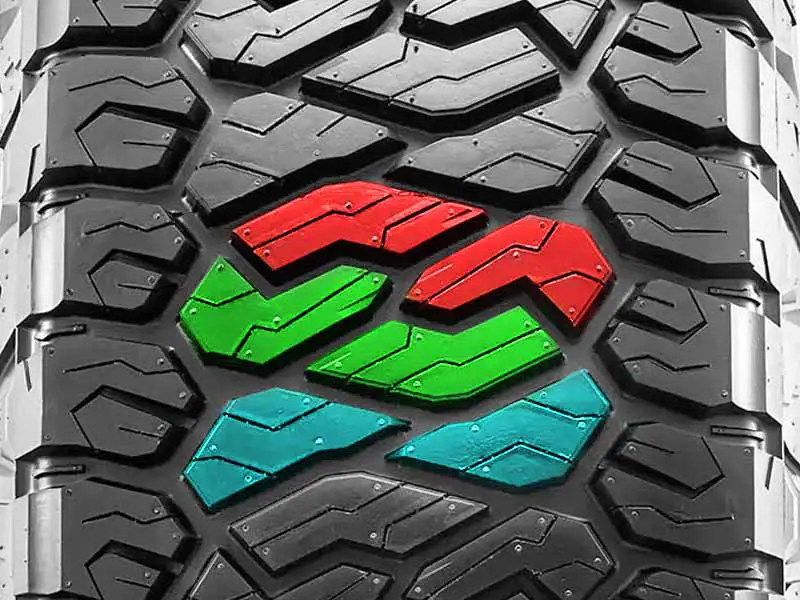Maxxis Razr AT811 vs BF Goodrich KO2: Both Maxxis Razr AT811 and the BF Goodrich KO2 although are labeled with all terrain tires, the Razr AT seems to lie in the hybrid terrain category (also sometimes called rugged terrain).
Rugged terrain tires are more aggressive than all terrain tires, as they have thicker shoulder blocks which resemble mud terrain tires, but at the same time compactly packed blocks in the middle (like an all terrain tire).

Examine the treads on these tires closely. They hold the key to knowing which to choose. In fact if you visit my "tread design" page, picking the right tire would never bother you.
This makes sense, because the Maxxis Razr is better off road in comparison. But let’s consider that after looking at their design, as otherwise, it’s not going to be as helpful.
Table of Contents
Tire Sizes
The Maxxis Razr A/T gives you more sizes (rim inches), and load/speed ratings. Though its tread depth is similar to KO2.
| Parameter | Maxxis Razr | BFG KO2 |
|---|---|---|
| Wheel Sizes | 15-24 inches | 15-22 inches |
| Load Ratings | XL, C, D, E, and F | C, D, and E only |
| Speed Ratings | Q, R, S, T, (H for XL) | R, S, and Q only |
| Weight Range | 30-84 lbs | 35-67 lbs |
| Tread Depth | 12 or 15/32″ | 15/32″ (except for 4) |
| Winter Rating | M+S & 3PMSF | M+S & 3PMSF |
| Warranty | 60k for P metric 50k for LT sizes | 50k on all sizes |
Moreover, the BF Goodrich KO2 is a lighter option out of the two, but gives you similar treadwear warranty, comparatively.
Let’s check these tires’s tread pattern.
Tread Design
Understanding tread design is crucial, but it can get hard sometimes. To understand the tread of Maxxis Razr, consider the following image.

All of these blocks (in the image above), exhibit a variety of characteristics. See how the chamfered edges on the blue blocks and notches on the red and green ones are placed. These features basically enhance off-road traction.
Moreover, they also carry full-depth rectilinear sipes. Meaning their slits go all the way deep, down to the tire’s base.
These sipes along with interconnected web of grooves supply superior grip and stability in wet conditions.
In contrast, the BF Goodrich KO2 employs a denser, crowded lug structure. Though like its competitor, it also incorporates similar full-depth sipes.

However, the key difference lies in the KO2’s lack of defined channels. Like there aren’t any proper circumferential or longitudinal grooves. Though you do get a very nice uniform design on these tread voids all over.
And they are also equipped with triangular shaped stone ejectors.
But the biggest highlight of this tire is its epic shoulders. They are very aggressive, forming tough passing lateral grooves, and joining up the even more aggressive sidewall lugs.
These shoulder blocks just like the Maxxis AT811 are also staggered. So they help with scooping things backwards to generate forward momentum.
And yes, worth reminding, both tires also have solid rim locks as well. So you can lower the tire’s air pressure with confidence.
Reducing air pressure, is basically a very common technique used in off-roading to improve traction. The principle behind this is that when the air pressure is reduced, it allows the tire’s sidewalls to flex more. And this flexing increases the contact surface area with the ground, allowing for enhanced grip.
On Road Traction
When it comes to pavement performance, the Maxxis Razr AT811 demonstrates commendable grip as measured by its relatively shorter braking distance and agile handling, compared to other rugged terrain tires.
Though in comparison with all-terrain tires, the BF Goodrich KO2, it’s overall gripping is not as great, due to it’s limited tread footprint.
The KO2 on the other side, not only features superior rubber to road connection, but you also get a relatively stiffer compound composition. This basically doesn’t allow the blocks to flex too much as the tire corners, especially.
Moreover, the tire’s full depth sipes everywhere enhance that traction, as they split open the blocks, allowing them to bite in to the surface, they are on.
Though their primary function is to provide wet grip, and that is not so great.
I mean the tire features a very nice hydroplaning resistance just like the Maxxis Razr, with interconnecting lateral and longitudinal grooves, clearing out water effectively, it still slips on corners, if you turn off the traction control in the vehicle.
This is due to its stiffer rubber composition, which don’t allow sipes to breath water in easily.
On the other hand, the Maxxis Razr is also not so great when it comes to wet surfaces. Though it’s softer rubber compound still offers almost similar grip compared to KO2, and that is appreciable, given that its a more aggressive hybrid tire.
Other on road factors
Beyond dry and wet traction, there are some other key factors worth discussing. These include fuel efficiency, wear, and ride comfort. Let’s talk about them one after another.
Fuel and Tread Life
Fuel depends on rolling resistance of the tire, and that can be explained by looking at the tire’s weight and tread composition.
And here, its not surprising to see Maxxis Razr A/T lacking behind by a lot of margin. Basically, the tire’s softer compound with tons of biters, grip in the surface with greater friction, and so they don’t want to let go too easily.
And that gets enhanced by the tire’s greater weight, which puts pressure on the tread blocks, keeping them rubbing against the surface with greater force.
This elevated friction levels also contribute a lot to the overall tire’s tread life, and it makes sense why its significantly lower than the KO2.
Though for marketing purposes the Maxis still gives you a very surprising 50k miles warranty for LT sizes, (which is similar to what BF Goodrich KO2 gives out).
Noise and Comfort
Noise and impact comfort significantly contribute to the overall ride quality of a tire.
Let’s discuss noise first, which is caused by air particles colliding with the tread walls, generating undesirable sound waves. So this means, that the balder the tire, the louder it becomes.
So simply put, due to its voided structure, the Maxxis Razr inherently generates more noise, compared to its counterpart.
Contrarily, the BF Goodrich KO2 manages noise more effectively. Despite its wide shoulder lugs, which typically allows for greater air flow towards the tread, the tire’s central interlocking lugs don’t allow those air particle to generate too much noise, thanks to their superior pitch sequencing abilties.
Pitch sequencing refers to the variations in lug geometry, where air particles hitting tread blocks at different angles create varying pitches and tones, which cancel each other out, reducing overall noise. Therefore, the BFG KO2 is the quieter tire between the two.
Coming towards the second part of overall ride quality…
Here the opposite happens. The Maxxis Razr AT811 outperforms the BFG KO2 as it’s softer tread compound features superior bumps absorption abilities.
With softer composition, basically the tire’s tread blocks flex, and dissipate the shocks energy in that, so that you can get a smoother ride.
Durability
Both tires are exceptionally durable, though the BF Goodrich KO2, despite its less aggressive nature, exhibits superior overall protection capabilities.
It although features 3 ply sidewalls just like its competitor, its carcass has stronger steel belts on top, and spirally wound nylon cap plies with thicker materiel. That’s why BFG say its their toughest tire ever (in A/T category), and they are not wrong about that at all.
The Maxxis Razr on the other hand, also features similar structure on the paper, though it’s cap plies aren’t spirally wound. So although its by a very small margin, the tire is not as strong as the KO2.
Off-Road Traction Performance
When evaluating the off-road traction performance of both tires, we found some interesting variations, especially in mud and rocks.
On rocky terrains, both tires have almost similar performance values. I mean you can’t put one tire over the other.
Basically main key factors required for efficient rock climbing, include durability and multidirectional grip, and both of these features are provided with both tires.
Each of them have 3-ply sidewalls and interlocking central structures, which provide substantial lateral and longitudinal gripping forces. And yes, with lowered air pressure, that grip is further enhanced in both cases, thanks to their powerful biters.
However, in muddy conditions, the performance of the BF Goodrich KO2 falls short.
And that’s because its interlocking structure, equipped with hook-shaped blocks. Like we saw in snow performance section, they really excel at retaining snow particles. But this is very problematic on muddy terrains.
The design doesn’t want to let go of mud particles too easily, so its lugs are always struggling to release them with the help of triangular-shaped stone ejectors, (for the most part).
Though its poor performance is saved, thanks to its aggressive shoulder lugs with staggered structure. They hold mud scoops, which account for throwing mud backwards to generate forward momentum.
Though still its performance cant outperform Maxxis Razr AT811, which has a hybrid design carrying “mud-terrain tire’s features”.
Snow Performance
Both tires are 3 peak mountain snowflake rated, so you can expect decent traction with them.
Though still out of them, the BF Goodrich KO2 is still much more commendable, thanks to it’s interlocking lug structure.
Let me explain why, but first you need to know this:
For optimal performance on winter terrains, it’s crucial to have contact between the tire’s tread and the snow, as snow adheres better to itself than to rubber.
That’s the reason why the BF Goodrich KO2, with its unique interlocking, C-shaped lugs combined with full-depth sipes, simply hang on to the snow particles to create better friction with the ground.
On the other hand, although the Maxxis Razr AT811 also features interconnected lateral and circumferential groove channels, which try to hold snow in too, the tire still falls short in this area, as its tread is very little siping.
So what to know in the end?
As a hybrid terrain tire, the Maxxis Razr AT811 exhibits superior off-road performance, which isn’t surprising. However, it’s noteworthy that this tire falls short of the BF Goodrich KO2’s durability, and that is really surprising.
Though its off-road capability is still superior, nonetheless.
But where off-road is low, on-road gets high, its the story of all off-road tires. So in on-road scenarios, the BF Goodrich KO2 rises above with its greater rubber-to-road contact, ensuring superior grip.
Though its wet traction is on par to its competitor.
And speaking of snowy terrains, despite both having 3pmsf ratings, the KO2 meets your expectations by offering effective maneuverability on almost all types of terrains.
